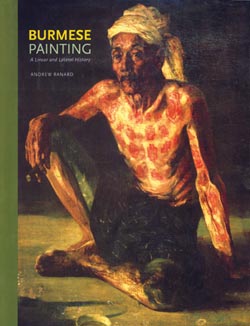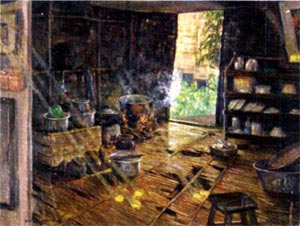
| By JIM ANDREWS | NOVEMBER, 2009 - VOLUME 17 NO.8 |
First comprehensive history of Burmese painting uncovers an aesthetic treasure house
When his diplomat father died in the early 1990s, Andrew Ranard inherited a small collection of Burmese paintings, and in a visit to Burma in 1994 he acquainted himself firsthand with the artists and their work. His research took him into an artistic world that was then little known outside Burma.
“I was bowled over,” he said later. “I felt as if I had landed on a Pitcairn Island of art, where some virtuoso European master had shipwrecked a century earlier and left a legacy of learning to his castaway descendants.”
 |
| Burmese Painting; a Linear and Lateral History, by Andrew Ranard, Silkworm Books, Chiang Mai, 2009, P 378 |
After several visits to Burma to follow up his new interest, he amended the metaphor. “Burma was a Galapagos Islands of art, where styles had evolved into arrested forms—strange-feathered birds that bore resemblance to the mainstream but which had shot off in unique directions.”
He traced and defined “so many varieties of styles—dead in the outside world but coexisting in harmony in Burma.”
Fifteen years after this first encounter, Ranard has published the first comprehensive history of Burmese art, a monumental anthology full of fascinating detail and anecdotes, illustrated by more than 300 reproductions of works by 175 painters.
Two of the illustrated works alone are sufficient to display the rich repertoire of Burmese art and explain the challenges faced by Burma’s painters—particularly in an era of austere military rule and tight censorship.
The two oil paintings were created by Than Aung in the early 1990s. Working in evident poverty in Bogalay, he managed to capture on a few square feet of canvas the aesthetic experience of entire generations of Burmese painters and to define the artistic dilemma that unites them all.
 |
| Above: Than Aung, Artist’s Wife and Child. 1992. Oil on canvas. Private Collection. |
The first painting shows what appears to be the kitchen of Than Aung’s home, its bamboo walls lined with the pots and pans, which also clutter the rough floor of worn bamboo slats. Light seems to penetrate holes in the roof. An untidy backyard can be glimpsed through an open door, where nature intrudes on the man-made disorder within.
Left and right of this mundane scene are subtle hints of its true meaning—half-hidden pictures, announcing the presence of beauty in this humble setting.
The second Than Aung painting reinforces his message with poignant effect, portraying his wife, squatting on the bare, splintered floor of their home, feeding their child from a tin plate.
Nothing could be simpler than that domestic scene. But, paradoxically, nothing could be more emotionally complex. The shabbiness of the setting highlights the beauty of the two subjects—the comely young woman, gracefully absorbed in her routine task, and her bonny child.
 |
| Below: Than Aung, Artist’s Home. c. 1990. Oil on canvas. Private Collection. |
It’s probably presumptuous to see a reference within this scene to the Madonna and Child of European Renaissance painters, but to a Western observer the association is inevitable—and serves as a reminder that Burmese art can’t be viewed in isolation or shielded from outside influences.
In his two arresting works, Than Aung seems to be telling the viewer to look below the surface of Burma’s unhappy history and the grinding poverty brought about by many years of misrule. There’s beauty beneath the dust and grime, he says—a beauty that he traces back through the centuries to the glories of Pagan.
The dilemma faced by successive generations of artists has been to mine that seam without creating a cliché out of specializing in the most immediate aesthetic source—landscapes and temples. Burma has produced, and continues to discover, outstanding landscape painters—including The Irrawaddy’s Harn Lay—but it’s left to artists like Than Aung to dig further in search of aesthetic meaning.
His work is still relatively unknown outside Burma., a fate shared by so many highly talented contemporary Burmese painters. The publication of “Burmese Painting” should raise the level of international interest in these neglected artists by creating a pictorial and textual record readily accessible for collectors and enthusiasts of fine art everywhere.